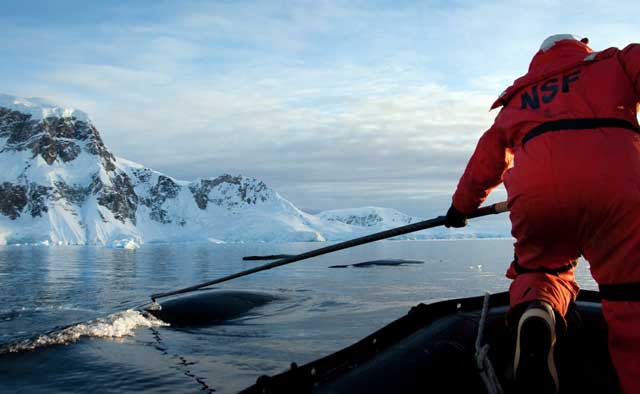Page 2/2 - Posted July 25, 2014
Scientists already observing changes in whale behavior from climate changeEach January, LTER scientists board a research vessel for a month-long cruise to collect samples and make observations across 180,000 square kilometers of ocean. Concurrently, a team is also based at Palmer Station For the last three years, whale biologists have joined the LTER cruise on the research vessel Laurence M. Gould “We still have all the same limitations and allowances as before – no more ship time and no more bunks,” Ducklow said, explaining that other science teams surrendered both berths on the ship and sampling time at sea. “One of the best things about our project – and the support staff – is the way everyone is so unselfish and committed to the whole project, not just their own particular goals.” Whale biologists aboard the ship conduct visual surveys while the vessel is under way to estimate the density of whales in a given area. Working from small rubber rafts called Zodiacs, the scientists also deploy satellite tags capable of tracking whale movements for several months at a time. Biopsy samples collected from whale skin and blubber provide information about the populations, such as the ratio of males to females and the presence of pregnant females. “All those parameters will help us to estimate the growth of that population over time,” Friedlaender said, adding that there are an estimated 5,000 humpbacks across the Antarctic Peninsula region. Most of the humpbacks that Friedlaender and his colleagues have tracked by satellite are from a population that breeds off the coast of Panama. Photographic evidence has placed some individual whales observed in the Antarctic from breeding populations as disparate as Brazil and American Samoa, according to Friedlaender. “Their navigation is incredible,” he said. The warmer climate and lack of winter-time sea ice has meant that non-breeders, in particular, are navigating a little less these days, staying south for longer than ever before. Friedlaender said humpback density has been highest in late May, well into the Antarctic winter, as the whales follow their prey into bays where the krill would expect to be protected by sea ice. Photo Credit: Peter Rejcek/Antarctic Photo Library
Marine technicians deploy a net during the 2010 LTER cruise.
Whale songs normally heard in breeding grounds thousands of miles away are being picked up by acoustical recorders on suction-cup tags in the ice-free feeding grounds. “As things warm up, the sea ice cover advances later and later in the year,” Friedlaender said. Another baleen species, the Antarctic minke whale “It’s a species that we’re very interested in, and concerned about, but it requires much more time to work with them,” Friedlaender. Time is one of the advantages the Palmer LTER offers in terms of understanding the life histories of these long-lived mammals. Humpbacks can live as long as humans can. “The LTER is a fantastic opportunity because the extended time gives us a chance to look at these long-lived animals over periods that are much more relevant to them,” Friedlaender said. “We’ll get so much more information out of it and understand the changes in these populations and how those are affected by changes in the environment in a much more useful way than we could with a more typical two- or three-year project.” NSF-funded research in this article: Hugh Ducklow, Columbia University, Award No. 1344502 |



For USAP Participants |
For The Public |
For Researchers and EducatorsContact UsU.S. National Science FoundationOffice of Polar Programs Geosciences Directorate 2415 Eisenhower Avenue, Suite W7100 Alexandria, VA 22314 Sign up for the NSF Office of Polar Programs newsletter and events. Feedback Form |



